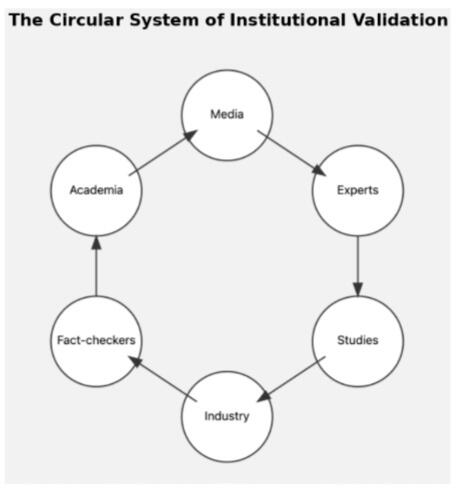by Josh Stylman via The Brownstone Institute,
When Avril Haines, Director of National Intelligence, announced during Event 201’s pandemic drill in 2019 that they would “flood the zone with trusted sources,” few understood this preview of coordinated narrative control. Within months, we watched it unfold in real time—unified messaging across all platforms, suppression of dissent, and coordinated narrative control that fooled much of the world.

But not everyone stayed fooled forever. Some saw through it immediately, questioning every aspect from day one. Others thought it was just incompetent government trying to protect us. Many initially accepted the precautionary principle—better safe than sorry. But as each policy failure pointed in the same direction—toward more control and less human agency—the pattern became impossible to ignore. Anyone not completely subsumed by the system eventually had to confront its true purpose: not protecting health or safety, but expanding control.
Once you recognize this pattern of deception, two questions should immediately arise whenever major stories dominate headlines: “What are they lying about?” and “What are they distracting us from?” The pattern of coordinated deception becomes unmistakable. Consider how media outlets spent three years pushing Russiagate conspiracies, driving unprecedented social division while laying the groundwork for what would become the greatest psychological operation in history. Today, while the media floods us with Ukraine coverage, BlackRock positions itself to profit from both the destruction and reconstruction. The pattern becomes unmistakable once you see it—manufactured crises driving pre-planned “solutions” that always expand institutional control.
Mainstream media operates on twin deceptions: misdirection and manipulation. The same anchors who sold us WMDs in Iraq, promoted “Russia collusion,” and insisted Hunter Biden’s laptop was “Russian disinformation” still occupy prime time slots. Just as we see with RFK, Jr.’s HHS nomination, the pattern is consistent: coordinated attacks replace substantive debate, identical talking points appear across networks, and legitimate questions are dismissed through character assassination rather than evidence. Being consistently wrong isn’t a bug—it’s a feature. Their role isn’t to inform but to manufacture consent.
The template is consistent: Saturate media with emotional spectacles while advancing institutional agendas with minimal scrutiny. Like learning to spot a fake smile or hearing a false note in music, you develop an instinct for the timing:
Money and Power:
Medical Control:
Digital Control:
As these deceptions become more obvious, different forms of resistance emerge. The truth-seeking takes different forms. Some become deep experts in specific deceptions—documenting early treatment successes with repurposed drugs, uncovering hospital protocol failures, or exploring the impact of vaccine injuries. Others develop a broader lens for seeing how narratives themselves are engineered.
Walter Kirn’s brilliant pattern recognition cuts to the heart of our manufactured reality. His tweets dissecting the United CEO murder coverage expose how even violent crimes are now packaged as entertainment spectacles, complete with character arcs and narrative twists. Kirn’s insight highlights a critical dimension of media control: by turning every crisis into an entertainment narrative, they divert attention from deeper questions. Instead of asking why institutional safeguards fail or who benefits, audiences become captivated by carefully scripted outrage. This deliberate distraction ensures that institutional agendas move forward without scrutiny.
His insight reveals how entertainment packaging serves the broader control system. While each investigation requires its own expertise, this pattern of narrative manipulation connects to a larger grid of deception. As I’ve explored in “The Information Factory” and “Engineering Reality,” everything from education to medicine to currency itself has been captured by systems designed to shape not just our choices, but our very perception of reality.
Most revealing is what they don’t cover. Notice how quickly stories disappear when they threaten institutional interests. Remember the Epstein client list? The Maui land grab? The mounting vaccine injuries? The silence speaks volumes.
Consider the recent whistleblower testimonies revealing suppressed safety concerns at Boeing, a company long entangled with regulatory agencies and government contracts. Two whistleblowers—both former employees who raised alarms about safety issues—died under suspicious circumstances. Coverage of their deaths disappeared almost overnight, despite the profound implications for public safety and corporate accountability. This pattern repeats in countless cases where accountability would disrupt entrenched power structures, leaving crucial questions unanswered and narratives tightly controlled.
These decisions aren’t accidental—they result from media ownership, advertiser influence, and government pressure, ensuring the narrative remains tightly controlled.
But perhaps most striking isn’t the media’s deception itself, but how thoroughly it shapes its consumers’ reality. Watch how confidently they repeat phrases clearly engineered in think tanks. Listen as they parrot talking points with religious conviction: “January 6th was worse than 9/11,” “Trust The Science™,” “Democracy is on the ballot” and, perhaps the most consequential lie in modern history, “Safe and Effective.”
The professional-managerial class proves especially susceptible to this programming. Their expertise becomes a prison of status—the more they’ve invested in institutional approval, the more fervently they defend institutional narratives. Watch how quickly a doctor who questions vaccine safety loses his license, how swiftly a professor questioning gender ideology faces review, how rapidly a journalist stepping out of line gets blacklisted.
The system ensures compliance through economic capture: your mortgage becomes your leash, your professional status your prison guard. The same lawyers who prides themselves on critical thinking will aggressively shut down any questioning of official narratives. The professor who teaches “questioning power structures” becomes apoplectic when students question pharmaceutical companies.
The circular validation makes the programming nearly impenetrable:
- Media cites “experts”
- Experts cite peer-reviewed studies
- Studies are funded by industry
- Industry shapes media coverage
- “Fact-checkers” cite media consensus
- Academia enforces approved conclusions
This self-reinforcing system forms a perfect closed loop:

Each component validates the others while excluding outside information. Try finding the entry point for actual truth in this closed system. The professional class’s pride in their critical thinking becomes darkly ironic—they’ve simply outsourced their opinions to “authoritative sources.”
Most disturbing is how willingly they’ve surrendered their sovereignty. Watch them defer:
- “I follow the science” (translation: I wait for approved conclusions)
- “According to experts” (translation: I don’t think for myself)
- “Fact-checkers say” (translation: I let others determine truth)
- “The consensus is” (translation: I align with power)
Their empathy becomes a weapon used against them. Question lockdowns? You’re killing grandma. Doubt transition surgery for minors? You’re causing suicides. Resist equity initiatives? You’re perpetuating oppression. The programming works by making resistance feel like cruelty.
Something remarkable is happening beneath the surface noise: a genuine awakening that defies traditional political boundaries. You see it in the subtle exchanges between colleagues when official narratives strain credibility. In the growing silence at dinner parties as propaganda talking points fall flat. In the knowing looks between strangers when public health theatre reaches new heights of absurdity.
This isn’t a movement in the traditional sense—it can’t be, since traditional movement structures are vulnerable to infiltration, subversion, and capture. Instead, it’s more like a spontaneous emergence of pattern recognition. A distributed awakening without central leadership or formal organization. Those who see through the patterns recognize the mass formation for what it is, while its subjects project their own programming onto others, dismissing pattern recognition as “conspiracy theories,” “anti-science,” or other reflexive labels designed to prevent genuine examination.
The hardest truth isn’t recognizing the programming—it’s confronting what it means for human consciousness and society itself. We’re watching real-time evidence that most human minds can be captured and redirected through sophisticated psychological operations. Their thoughts aren’t their own, yet they’d die defending what they’ve been programmed to believe.
This isn’t just media criticism anymore—it’s an existential question about human consciousness and free will. What does it mean when a species’ capacity for independent thought can be so thoroughly hijacked? When natural empathy and moral instincts become weapons of control? When education and expertise actually decrease resistance to programming?
The programming works because it hijacks core human drives:
- The need for social acceptance (e.g., masking as a visible symbol of conformity)
- The desire to be seen as good/moral (e.g., adopting performative stances on social issues without deeper understanding)
- The instinct to trust authority (e.g., faith in public health officials despite repeated policy reversals)
- The fear of ostracism (e.g., avoiding dissent to maintain social harmony)
- The comfort of conformity (e.g., parroting narratives to avoid cognitive dissonance)
- The addiction to status (e.g., signaling compliance to maintain professional or social standing)
Each natural human trait becomes a vulnerability to be exploited. The most educated become the most programmable because their status addiction runs deepest. Their “critical thinking” becomes a script running on corrupted hardware.
This is the core challenge of our time: Can human consciousness evolve faster than the systems designed to hijack it? Can pattern recognition and awareness spread faster than manufactured consensus? Can enough people learn to read between the lies before the programming becomes complete?
The stakes could not be higher. This isn’t just about politics or media literacy—it’s about the future of human consciousness itself. Whether our species maintains the capacity for independent thought may depend on those who can still access it helping others break free from the spell.
The matrix of control deepens daily, but so does the awakening. The question is: Which spreads faster—the programming or the awareness of it? Our future as a species may depend on the answer.
https://www.zerohedge.com/political/read-between-lies-pattern-recognition-guide





